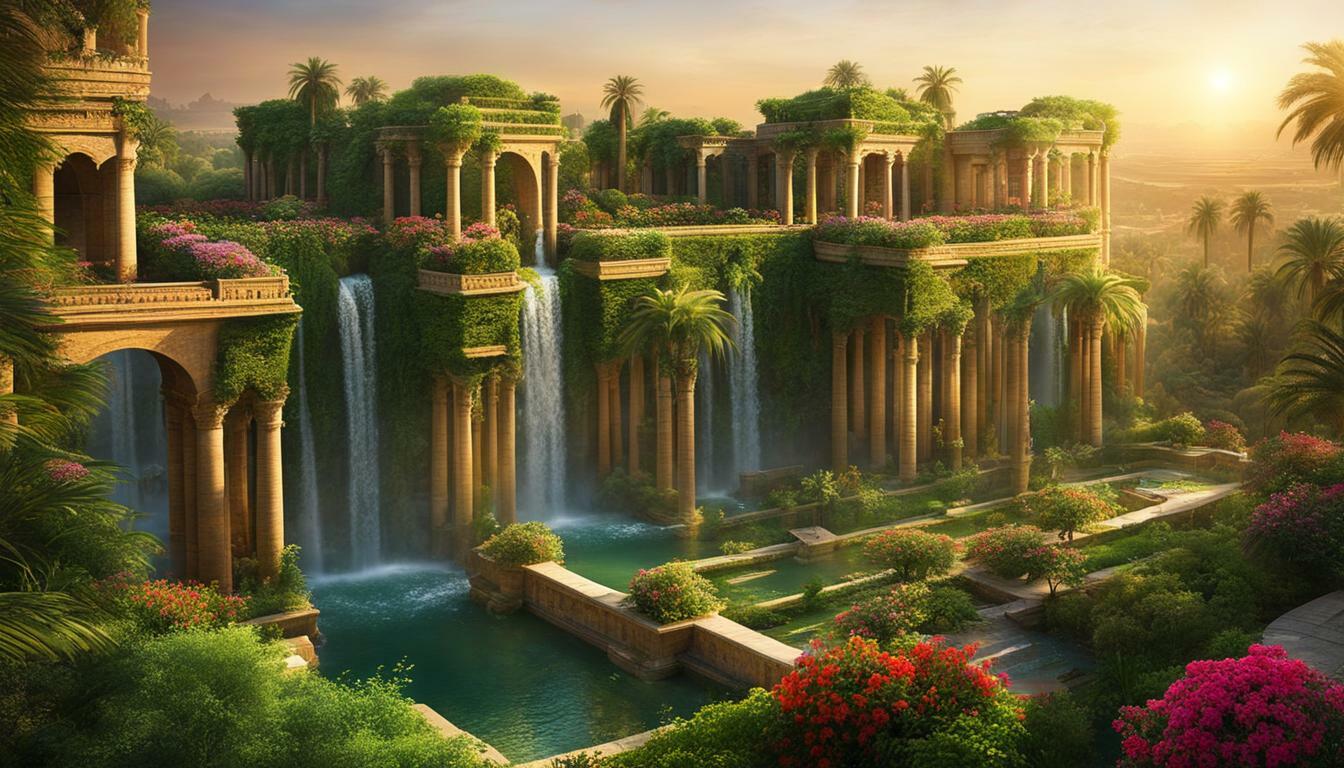Unlocking Mysteries: Are the Hanging Gardens of Babylon Real?
Dive into history as we explore the intriguing question: are the Hanging Gardens of Babylon real? The Hanging Gardens of Babylon have long fascinated historians and archaeologists due to their mysterious nature. These gardens were said to be a marvel of engineering, with lush vegetation cascading down terraces in ancient Babylon.
Key Takeaways:
- The existence of the Hanging Gardens of Babylon remains a mystery, with no definitive archaeological evidence to prove their existence.
- Ancient Greek and Roman texts describe the gardens as a remarkable feat of engineering, created by Babylonian king Nebuchadnezzar II for his wife, Amytis.
- Dr. Stephanie Dalley proposes an alternative theory, suggesting that the gardens may have been located in Nineveh, the capital of the Assyrian empire.
- New translations of ancient texts and recent excavations in Nineveh provide evidence supporting the theory that the Hanging Gardens were located there.
- Debates among scholars continue regarding the true location of the Hanging Gardens and their historical significance.
Ancient Greek and Roman texts paint vivid pictures of the luxurious Hanging Gardens of Babylon.
Amid the hot, arid landscape of ancient Babylon, lush vegetation cascaded like waterfalls down the terraces of the 75-foot-high garden. Exotic plants, herbs and flowers dazzled the eyes, and fragrances wafted through the towering botanical oasis dotted with statues and tall stone columns.
The Hanging Gardens of Babylon were one of the Seven Wonders of the Ancient World, listed by Hellenic culture. They were described as a remarkable feat of engineering with an ascending series of tiered gardens containing a wide variety of trees, shrubs, and vines, resembling a large green mountain constructed of mud bricks. It was said to have been built in the ancient city of Babylon, near present-day Hillah, Babil province, in Iraq. The Hanging Gardens’ name is derived from the Greek word κρεμαστός (kremastós, lit.’overhanging’), which has a broader meaning than the modern English word “hanging” and refers to trees being planted on a raised structure such as a terrace.
According to one legend, the Hanging Gardens were built alongside a grand palace known as The Marvel of Mankind, by the Neo-Babylonian King Nebuchadnezzar II (who ruled between 605 and 562 BC), for his Median wife, Queen Amytis, because she missed the green hills and valleys of her homeland. This was attested to by the Babylonian priest Berossus, writing in about 290 BC, a description that was later quoted by Josephus. The construction of the Hanging Gardens has also been attributed to the legendary queen Semiramis and they have been called the Hanging Gardens of Semiramis as an alternative name.
Ancient writer Josephus, quoting Berossus, described the reign of Nebuchadnezzar II and credited him with the construction of the Hanging Gardens: “In this palace he erected very high walls, supported by stone pillars; and by planting what was called a pensile paradise, and replenishing it with all sorts of trees, he rendered the prospect an exact resemblance of a mountainous country. This he did to gratify his queen, because she had been brought up in Media, and was fond of a mountainous situation.”
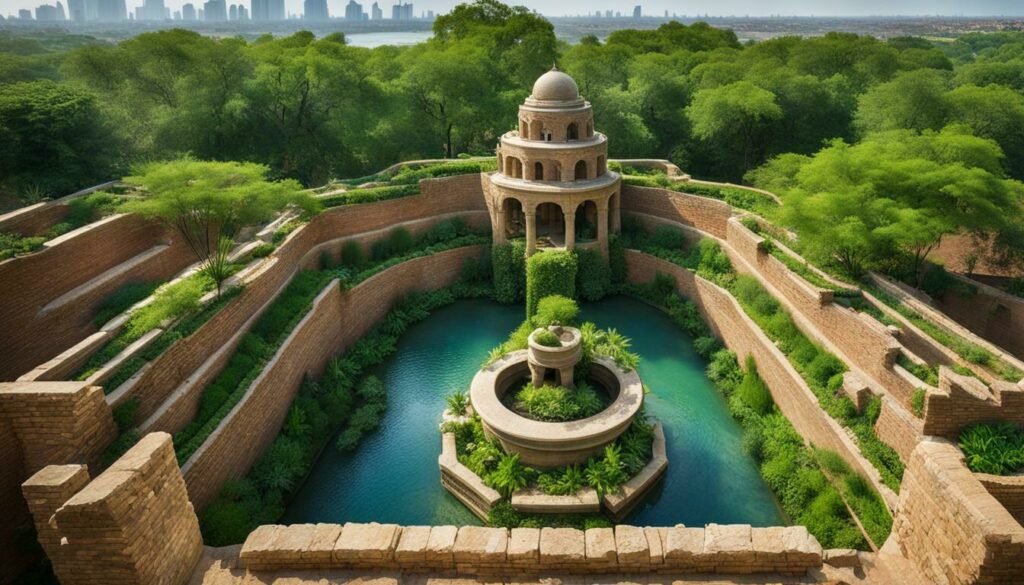
The descriptions of the Hanging Gardens vary, but they all portray a magnificent spectacle. Diodorus Siculus, a Greek historian, described a square-shaped garden with tiered terraces and brick walls. The uppermost gallery was 50 cubits high, and the walls were 22 feet thick. Quintus Curtius Rufus, a Roman historian, mentioned that the gardens were located on top of a citadel with a circumference of 20 stadia. Strabo, a Greek geographer, described terraced gardens with hollow, cube-shaped pillars filled with soil to hold the roots of larger trees. He also mentioned an Archimedes’ screw that brought water from the Euphrates river to the gardens.
The Disputed Origin
The origin of the Hanging Gardens remains a subject of debate among scholars. Some believe that the gardens were located in the city of Babylon itself, while others propose that they were in Nineveh, an ancient Assyrian city. There are no extant Babylonian texts that mention the gardens, and no definitive archaeological evidence has been found in Babylon.
Stephanie Dalley, an Assyriologist at the University of Oxford, is among those who suggest that the Hanging Gardens were actually located in Nineveh. She argues that the gardens were built by the Assyrian king Sennacherib in his capital city, not by Nebuchadnezzar II in Babylon. Dalley points to evidence in new translations of ancient texts that describe Sennacherib’s own “unrivaled palace” and a “wonder for all peoples.” Recent excavations around Nineveh have uncovered evidence of an extensive aqueduct system that delivered water from the mountains, along with bas reliefs depicting a lush garden watered by an aqueduct.
However, the debate continues, and the true location and existence of the Hanging Gardens of Babylon remain shrouded in mystery. Archaeologists and historians continue their search for clues, hoping to unravel the secrets of this ancient wonder.
| Ancient Writers | Description |
|---|---|
| Josephus | Described high walls supported by stone pillars and a “pensile paradise” with various trees |
| Diodorus Siculus | Described a square-shaped garden with tiered terraces, brick walls, and irrigation from the nearby Euphrates river |
| Quintus Curtius Rufus | Described the gardens on top of a citadel with a circumference of 20 stadia |
| Strabo | Described terraced gardens with cube-shaped pillars filled with soil and irrigation through an Archimedes’ screw |
Nebuchadnezzar II and the Construction of the Gardens
Babylonian king Nebuchadnezzar II was said to have constructed the luxurious Hanging Gardens in the sixth century B.C. as a gift to his wife, Amytis, who was homesick for the beautiful vegetation and mountains of her native Media (the northwestern part of modern-day Iran). The construction of these gardens was a remarkable feat of engineering, requiring a sophisticated irrigation system to bring water to the top of the gardens.
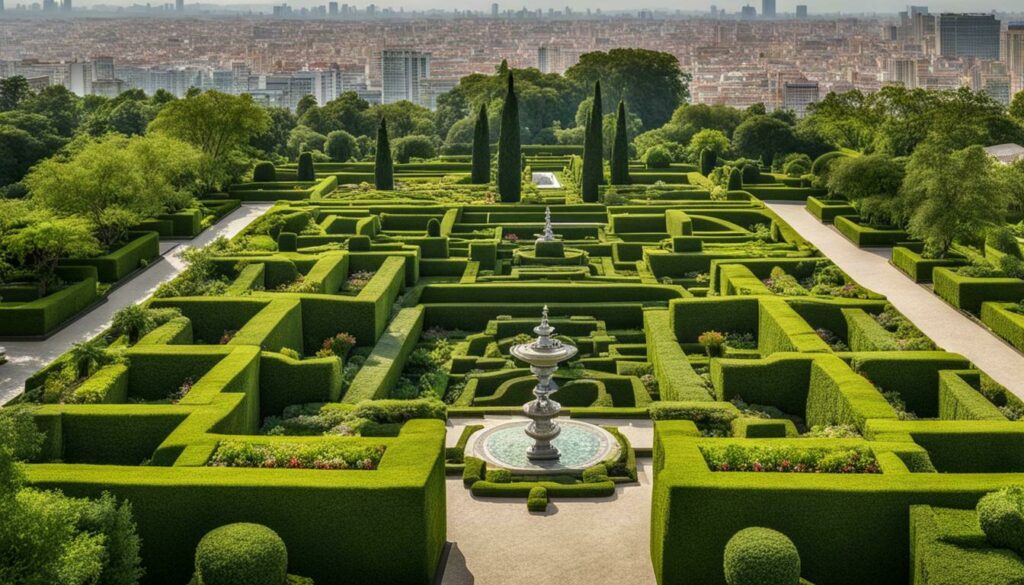
To make the desert bloom, it is believed that a system of pumps, waterwheels, and cisterns would have been employed to raise and deliver water from the nearby Euphrates River to the top of the gardens. These engineering marvels allowed the gardens to flourish and create a botanical oasis in the arid landscape of Babylon. The scale and beauty of the gardens made them one of the most magnificent structures of the Babylonian empire.
Nebuchadnezzar II and the Engineering Marvels
King Nebuchadnezzar II played a crucial role in the construction of the Hanging Gardens. As one of the most powerful kings of the Babylonian empire, he sought to create a grand monument that would not only showcase his kingdom’s wealth and prosperity but also fulfill the desires of his wife.
The gardens were designed as a series of ascending terraces, resembling a large green mountain. Each terrace was filled with lush vegetation, including exotic plants, herbs, and flowers. The terraces were supported by high walls, constructed with stone pillars, and paved with baked bricks. The gardens were a marvel of architecture and horticulture.
The challenge of irrigating the gardens in the desert environment was overcome through an ingenious system of water transportation. It is believed that a network of canals, pumps, and waterwheels were used to bring water from the Euphrates River to the topmost terrace, allowing it to cascade down the terraces like waterfalls. The use of this advanced irrigation system enabled the gardens to thrive and remain lush throughout the year.
The construction of the Hanging Gardens of Babylon not only showcased the immense power and wealth of Nebuchadnezzar II but also demonstrated the expertise of the Babylonian engineers. These gardens stood as a testament to the advanced engineering skills of the Babylonian empire and their ability to create stunning architectural wonders in the midst of a challenging environment.
Table: Key Features of the Hanging Gardens of Babylon
| Feature | Description |
|---|---|
| Terraces | Ascending series of tiered gardens |
| Vegetation | Exotic plants, herbs, and flowers |
| Structures | High walls supported by stone pillars |
| Irrigation system | Network of canals, pumps, and waterwheels |
Despite the grandeur and significance attached to the Hanging Gardens of Babylon, their existence remains shrouded in mystery. The lack of archaeological evidence and the conflicting accounts in ancient texts have fueled debates among scholars and historians. However, the legacy of the gardens persists, captivating the imagination and curiosity of people throughout history.
Lack of Archaeological Evidence
Despite extensive searches, no relics or structures related to the Hanging Gardens of Babylon have been discovered. For centuries, archaeologists have searched in vain for any physical evidence that could confirm the existence of this ancient wonder. The lack of archaeological evidence has led some skeptics to question whether the Hanging Gardens were just a myth or a figment of ancient imagination. Theories and debates continue to surround the true nature and location of these gardens.
Archaeologists have faced significant challenges in uncovering the Hanging Gardens. The gardens were said to have been built in ancient Babylon, a city located in modern-day Iraq. However, the shifting course of the Euphrates River over thousands of years has made it difficult to locate any remnants of the gardens. The lack of written documentation and the absence of Babylonian texts specifically mentioning the gardens further complicates the search.
Recent excavations around Babylon have failed to yield any significant findings related to the Hanging Gardens. German archaeologists spent two decades in the early 20th century searching for signs of the gardens, but their efforts were in vain. The absence of any relics or structures has fueled the debate about whether the Hanging Gardens were nothing more than a fantastical tale.
Despite the lack of physical evidence, some scholars and researchers continue to explore alternative explanations for the existence of the Hanging Gardens. One such theory is proposed by Dr. Stephanie Dalley, an honorary research fellow at Oxford University. She suggests that the gardens were actually located in Nineveh, the capital city of the Assyrian empire, rather than Babylon.
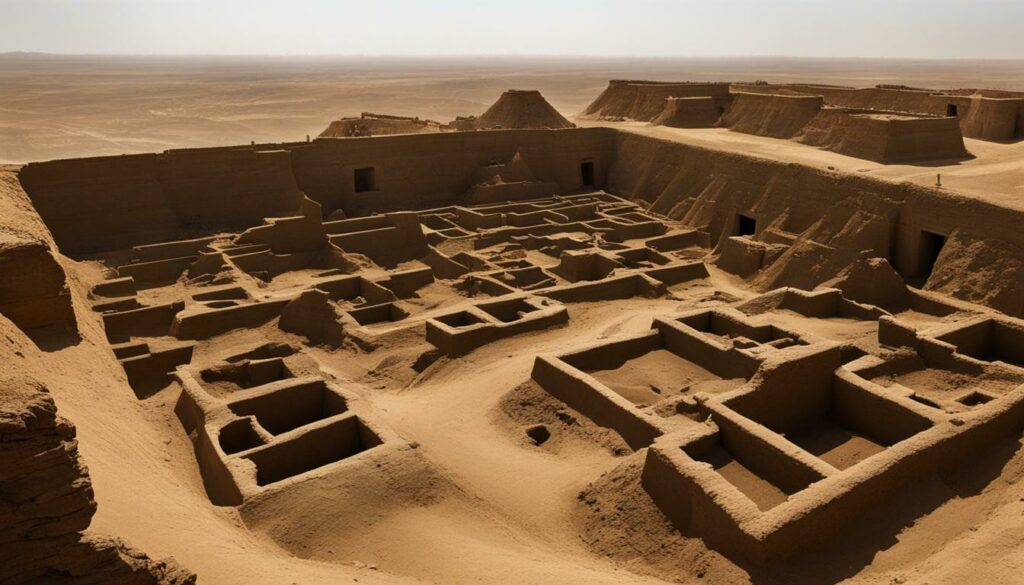
Dr. Stephanie Dalley’s Theory
Dr. Stephanie Dalley’s theory challenges the traditional belief that the Hanging Gardens were built by King Nebuchadnezzar II in Babylon. She proposes that the gardens were constructed by the Assyrian king Sennacherib in Nineveh, located around 300 miles north of Babylon.
Dalley’s theory is based on her extensive research and study of ancient cuneiform texts. In her book “The Mystery of the Hanging Garden of Babylon: An Elusive World Wonder Traced,” she presents evidence from new translations of ancient texts that describe Sennacherib’s own “unrivaled palace” and a “wonder for all peoples.” These texts also mention a bronze water-raising screw, similar to Archimedes’ screw developed centuries later, which could have been used to irrigate the gardens.
Recent excavations around Nineveh have provided further support for Dalley’s theory. Evidence of an extensive aqueduct system has been uncovered, which was likely used to deliver water from the mountains. Bas reliefs from the royal palace in Nineveh depict a lush garden watered by an aqueduct, fitting the description of the Hanging Gardens.
Evidence from New Translations
New translations of ancient texts and archaeological discoveries have shed light on the possibility of Nineveh being the true location of the Hanging Gardens. These findings suggest that the gardens may have been misattributed to Babylon due to the Assyrian conquest of the city.
Historical texts mention that after the Assyrian conquest of Babylon in 689 B.C., Nineveh was referred to as the “New Babylon.” King Sennacherib even renamed the city gates after those of Babylon’s entrances. This historical context could explain the confusion surrounding the true location of the gardens.
While Dalley’s theory provides an alternative perspective on the Hanging Gardens, there are ongoing debates and differing opinions among scholars. Some argue that the gardens may have been located in Babylon after all, while others propose alternative locations or question the existence of the gardens entirely.
The search for clues and evidence to unravel the mysteries of the Hanging Gardens of Babylon continues. Archaeologists, historians, and researchers are dedicated to uncovering more information and shedding light on this ancient wonder of the world.
Dr. Stephanie Dalley proposes a new perspective on the location and builder of the Hanging Gardens of Babylon.
The mystery surrounding the location and existence of the Hanging Gardens of Babylon has puzzled historians and archaeologists for centuries. According to ancient Greek and Roman texts, these gardens were described as a remarkable feat of engineering, with lush vegetation cascading down terraces and exotic plants adorning the surroundings. However, the lack of physical evidence and the discrepancy between historical accounts have led many to question their reality.
Enter Dr. Stephanie Dalley, an honorary research fellow at England’s Oxford University and an expert in ancient Mesopotamian languages. In her book “The Mystery of the Hanging Garden of Babylon: An Elusive World Wonder Traced,” Dalley presents a new theory that challenges the traditional understanding of the gardens.
Based on her extensive research and translation of ancient cuneiform texts, Dalley proposes that the Hanging Gardens were not located in Babylon, as commonly believed, but rather in Nineveh, the capital of the Assyrian empire. She suggests that it was the Assyrian king Sennacherib, not Nebuchadnezzar II, who built the gardens in the early seventh century B.C., a century earlier than previously thought.
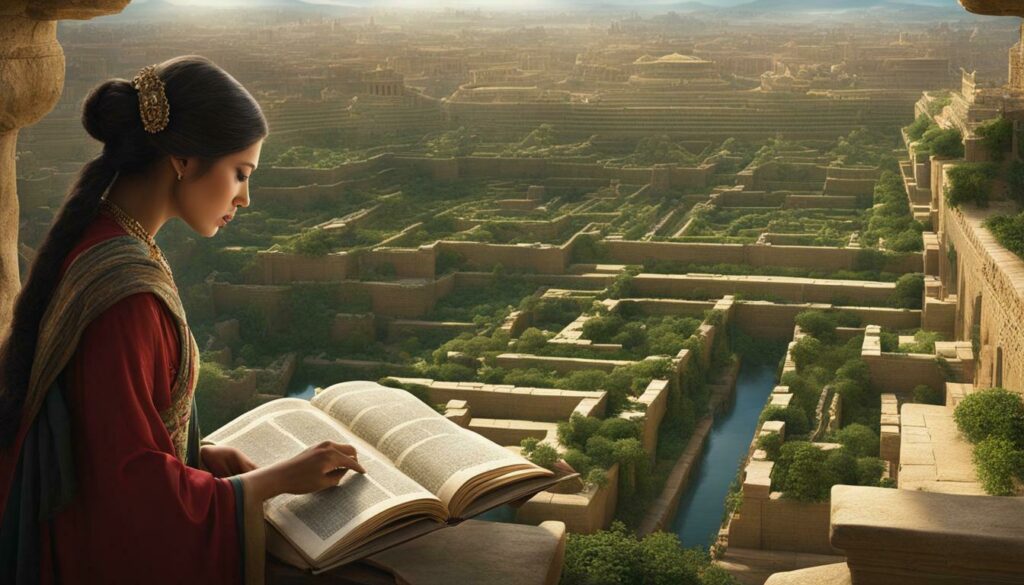
New translations of ancient texts have revealed descriptions of Sennacherib’s “unrivaled palace” and a “wonder for all peoples,” which could be references to the Hanging Gardens. Additionally, recent excavations around Nineveh have uncovered evidence of an extensive aqueduct system and bas reliefs depicting a lush garden watered by an aqueduct.
Dalley’s theory challenges the popular belief that the Hanging Gardens were purely mythical or located in Babylon. She suggests that the confusion about the location of the gardens may have arisen from the Assyrian conquest of Babylon and the renaming of Nineveh as the “New Babylon.”
While Dalley’s theory is not without controversy, it provides a compelling alternative perspective on the Hanging Gardens of Babylon. It highlights the importance of reevaluating historical accounts and considering new evidence in our understanding of ancient wonders.
Conclusion
In conclusion, Dr. Stephanie Dalley’s theory presents a new perspective on the location and builder of the Hanging Gardens of Babylon. By challenging the traditional understanding and proposing that the gardens were located in Nineveh, she offers a fresh interpretation based on new translations of ancient texts and archaeological discoveries. While the debate about the true location of the Hanging Gardens continues, Dalley’s research adds to the rich tapestry of historical discovery and invites us to reconsider our understanding of ancient wonders.
The Case for Nineveh
According to Dr. Dalley, the Hanging Gardens were actually built in Nineveh by the Assyrian king Sennacherib. This alternative theory challenges the long-standing belief that the gardens were constructed by Babylonian king Nebuchadnezzar II. Dr. Dalley, an esteemed Assyriologist at the University of Oxford, has spent years researching ancient texts and examining archaeological evidence to support her hypothesis.
One piece of potential evidence comes from Diodorus Siculus, a Greek historian from the 1st century B.C. Diodorus wrote that the gardens were built by Semiramis, a legendary Assyrian queen. Historical documents show that the Assyrian king Sennacherib, who ruled in the 7th century B.C., had extensive gardens at his palace in Nineveh, along with the engineering knowledge to irrigate them.
A surviving carving from a palace at Nineveh even depicts gardens and a canal, providing visual evidence of the lush greenery that existed in the ancient city. Additionally, Sennacherib’s grandson Ashurbanipal maintained a zoo with animals brought from various parts of the empire, indicating a penchant for creating magnificent and awe-inspiring environments.
The confusion regarding the location of the gardens may stem from the fact that Nineveh was referred to as the “New Babylon” after the Assyrian conquest of Babylon in 689 B.C. Sennacherib even renamed the city gates after Babylon’s entrances, further blurring the distinction between the two cities. These factors, coupled with the lack of physical evidence in Babylon, have led Dr. Dalley to propose that the Hanging Gardens were mislabeled and should actually be known as the Hanging Gardens of Nineveh.
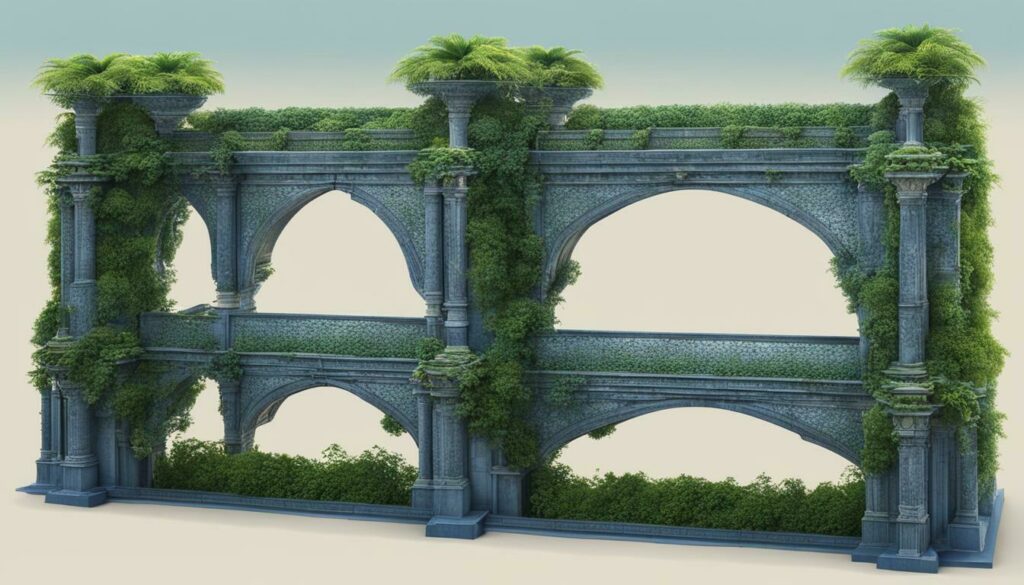
| Assyrian King | Assyrian Capital | Period |
|---|---|---|
| Sennacherib | Nineveh | 7th century B.C. |
| Diodorus Siculus | Greek historian from the 1st century B.C. | – |
| Nebuchadnezzar II | Babylon | 6th century B.C. |
| Ashurbanipal | Nineveh | 7th century B.C. |
The theory that the Hanging Gardens were located in Nineveh is supported by recent excavations near the modern-day city of Mosul, which have uncovered evidence of an extensive aqueduct system that delivered water from the mountains. Bas reliefs from the royal palace in Nineveh depict a lush garden watered by an aqueduct, providing further credibility to Dr. Dalley’s hypothesis.
Recent Excavations and Translations: Evidence of Lush Gardens in Nineveh
Recent excavations and translations of ancient texts provide evidence of an extensive aqueduct system and lush gardens in Nineveh. The Assyrian king Sennacherib, who ruled in the 7th century B.C., is believed to have built these gardens in his capital city, Nineveh, located near the modern-day city of Mosul, Iraq. This new theory challenges the traditional belief that the Hanging Gardens of Babylon were located in the city of Babylon itself.
Bas reliefs from the royal palace in Nineveh depict a vibrant garden watered by an aqueduct, demonstrating the Assyrian’s advanced engineering techniques. The rugged topography surrounding Nineveh would have made it easier to elevate water to the gardens, in contrast to the flat surroundings of Babylon. The archaeological findings also include an inscription stating, “Sennacherib king of the world…Over a great distance, I had a watercourse directed to the environs of Nineveh.”
This evidence suggests that Sennacherib constructed a magnificent garden, similar to the descriptions of the Hanging Gardens, as mentioned by ancient Greek and Roman writers. The ancient texts describe Sennacherib’s “unrivaled palace” and a “wonder for all peoples,” both of which align with the grandeur associated with the Hanging Gardens.
Evidence from New Translations
New translations of ancient texts have shed further light on the existence of the gardens in Nineveh. Dr. Stephanie Dalley, an Assyriologist from the University of Oxford, has extensively studied these texts and believes that the Hanging Gardens were indeed located in Nineveh, rather than Babylon. She points to the mention of a bronze water-raising screw, similar to Archimedes’ screw, which could have been used for irrigation in the gardens.
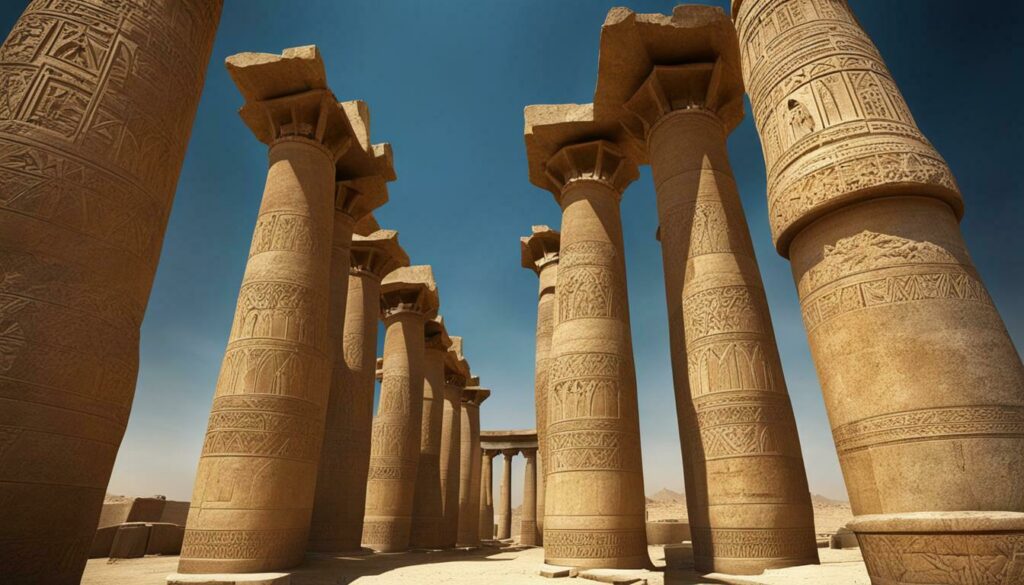
These recent discoveries challenge the previous belief that the gardens were a “historical mirage” due to the lack of physical evidence. While the debate surrounding the true location of the Hanging Gardens continues, the evidence from recent excavations and translations suggests that they may have been the Hanging Gardens of Nineveh, built by King Sennacherib.
| Aqueduct System | Lush Gardens | Ancient Texts |
|---|---|---|
| A recent excavation in Nineveh has uncovered an extensive aqueduct system that supplied water to the gardens. | The bas reliefs from the royal palace in Nineveh depict a lush garden watered by the aqueduct system. | New translations of ancient texts mention Sennacherib’s “unrivaled palace” and a “wonder for all peoples,” supporting the existence of the gardens. |
| The aqueducts demonstrate the advanced engineering capabilities of the Assyrians. | The presence of a vibrant garden contradicts the arid landscape often associated with Babylon. | The ancient texts offer descriptions that align with the grandeur associated with the Hanging Gardens. |
- Aqueduct system
- Lush gardens
- Ancient texts
The evidence from recent excavations and translations provides a compelling case for the existence of the Hanging Gardens in Nineveh. While the debate continues among scholars, the wonders of these ancient gardens continue to captivate our imagination and inspire further exploration into the history of the ancient world.
Scholars and historians continue to debate the validity of various theories about the Hanging Gardens of Babylon.
The Hanging Gardens of Babylon, one of the Seven Wonders of the Ancient World, have long fascinated scholars and historians. The gardens were described as a remarkable feat of engineering with tiered gardens filled with trees, shrubs, and vines. However, the location and existence of the gardens have been the subject of much debate.
According to ancient Greek and Roman texts, the gardens were built in the ancient city of Babylon by King Nebuchadnezzar II in the 6th century B.C. as a gift to his wife, Amytis. These texts describe the gardens as an oasis of lush vegetation, with waterfalls and statues amidst terraced gardens. However, these accounts were written centuries after the alleged destruction of the gardens, leading to skepticism among some scholars.
Dr. Stephanie Dalley, an esteemed scholar in ancient Mesopotamian languages, has put forth an alternative theory regarding the location of the Hanging Gardens. In her research, she suggests that the gardens were actually built in Nineveh, the capital of the Assyrian empire, by King Sennacherib around the 7th century B.C. This theory challenges the long-held belief that the gardens were located in Babylon.
Ancient texts, including those written by Greek historian Diodorus Siculus, mention the gardens but offer no definitive evidence of their location. Recent excavations around Nineveh have uncovered evidence of an extensive aqueduct system and bas reliefs depicting a lush garden, providing support for Dr. Dalley’s theory.
While the debate continues, there is no concrete archaeological evidence to confirm the exact location of the Hanging Gardens. Some scholars argue that the lack of physical remnants may indicate that the gardens were purely mythical or that they were destroyed over time. Others maintain that the gardens may have existed in Babylon, but the shifting course of the Euphrates River and the passage of time have made it difficult to identify their remains.

Despite the ongoing debates, the allure of the Hanging Gardens of Babylon persists. Whether they were located in Babylon or Nineveh, these gardens represent the ingenuity and creativity of ancient civilizations. They continue to captivate our imaginations and inspire us to explore the mysteries of the past.
Alternative Theories and Debates
The possibility of alternative theories regarding the Hanging Gardens of Babylon has sparked ongoing debates among scholars and historians. One such theory suggests that the gardens may have been the creation of a Syrian king, while others argue that they could have been constructed by the legendary Assyrian queen Semiramis.
Greek historian Diodorus Siculus mentions that the gardens were built by a Syrian king, but the exact details and historical accuracy of this claim remain uncertain. The absence of concrete evidence has led some to question whether the gardens existed at all, considering them to be figments of ancient Greek imagination.
Despite these debates, many scholars maintain that the Hanging Gardens were indeed a remarkable wonder of the ancient world. They continue to search for clues and evidence that may shed light on the true nature and location of these legendary gardens, hoping to unravel the mysteries that have captivated us for centuries.
Section 9: The Search for Clues
Archaeologists and historians have dedicated significant time and resources to unravel the mysteries surrounding the Hanging Gardens. The lack of physical evidence has posed a challenge, but numerous theories and discoveries have shed light on the possible location and existence of this ancient wonder.
One important institution involved in the search for clues is the British Museum. As a leading authority on world history, the museum has played a crucial role in preserving and studying ancient artifacts, including those related to the Hanging Gardens of Babylon. Its extensive collection houses a wealth of historical texts, ancient manuscripts, and archaeological findings that provide valuable insights into the ancient world.
Historians and researchers have meticulously examined these materials in the hopes of uncovering references or descriptions that could corroborate the existence of the Hanging Gardens. Their efforts have led to the discovery of ancient texts, such as the writings of Berossus and Josephus, which mention the gardens and provide some details about their construction and purpose.
However, the search for physical evidence has been more challenging. Recent excavations near the ancient city of Nineveh, modern-day Mosul in Iraq, have uncovered intriguing clues that support the theory that the Hanging Gardens were located in this Assyrian city. The evidence includes elaborate bas-reliefs depicting lush gardens, aqueducts, and inscriptions referring to the magnificent palace and its surrounding environs.
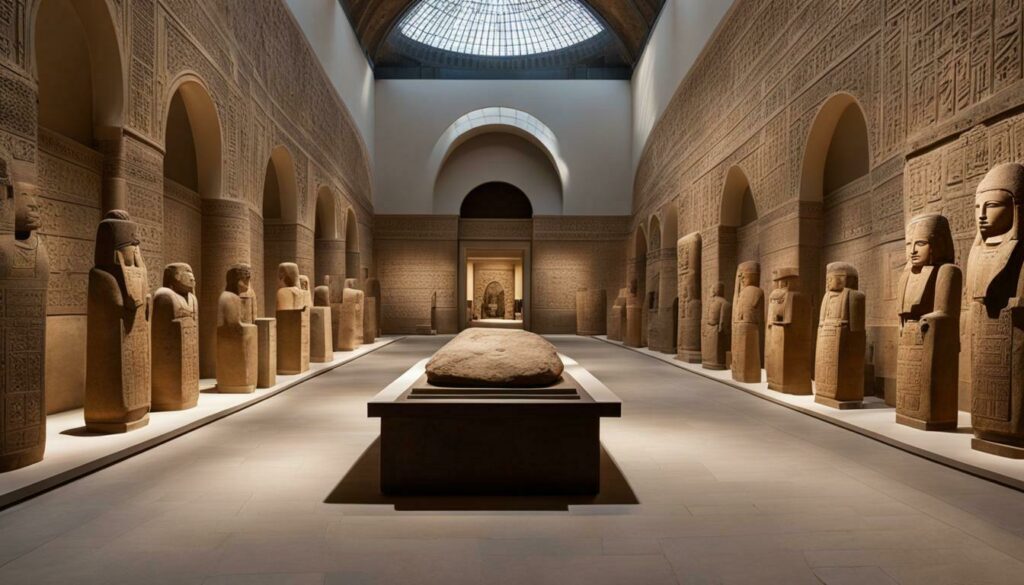
These findings align with the research conducted by Dr. Stephanie Dalley, an esteemed Assyriologist and part of the Oriental Institute at England’s Oxford University. Dr. Dalley proposes that the Hanging Gardens were indeed the Hanging Gardens of Nineveh, rather than Babylon.
The excavated artifacts, including stone pillars and ancient inscriptions, provide a glimpse into the grandeur of the Assyrian empire and its mastery of irrigation systems. These discoveries support the notion that the engineering marvels required to create such a magnificent garden could be found in Nineveh, making it a plausible location for the Hanging Gardens.
While debates and alternative theories persist, the ongoing efforts of archaeologists, historians, and institutions like the British Museum continue to shed light on the mysteries surrounding the Hanging Gardens of Babylon. New translations of ancient texts and the uncovering of previously unknown archaeological sites offer hope for further discoveries and a deeper understanding of this ancient wonder.
Summary:
- Archaeologists and historians have dedicated significant time and resources to unravel the mysteries surrounding the Hanging Gardens.
- The British Museum has played a crucial role in preserving and studying ancient artifacts related to the Hanging Gardens.
- Ancient texts such as those by Berossus and Josephus provide some details about the construction and purpose of the gardens.
- Excavations near Nineveh have uncovered compelling evidence supporting the theory that the Hanging Gardens were located there.
- Dr. Stephanie Dalley’s research aligns with the notion that the Hanging Gardens were the Hanging Gardens of Nineveh.
- Debates and alternative theories persist, but ongoing efforts hold promise for further discoveries and a deeper understanding of this ancient wonder.
The true nature of the Hanging Gardens of Babylon remains a captivating mystery, with conflicting theories and limited evidence.
The Hanging Gardens of Babylon are one of the Seven Wonders of the Ancient World, but their existence is still a subject of debate among historians and archaeologists. The lack of preserved Babylonian writings and archaeological evidence from that time period has made it difficult to determine the true nature of these gardens. Various theories suggest different locations and builders, adding to the intrigue surrounding this ancient wonder.
The Legend of the Hanging Gardens
Ancient Greek and Roman texts describe the Hanging Gardens as an engineering marvel with tiered gardens filled with a variety of trees, shrubs, and vines. These texts also attribute the construction of the gardens to the Babylonian king Nebuchadnezzar II, who supposedly built them for his Median queen, Amytis, to remind her of her lush homeland. However, these accounts were written centuries after the alleged destruction of the gardens, and no firsthand descriptions or physical evidence exist.
Nebuchadnezzar II and the Construction of the Gardens
According to some accounts, King Nebuchadnezzar II employed advanced irrigation systems, such as pumps, waterwheels, and cisterns, to raise water from the nearby Euphrates River and deliver it to the top of the gardens. The engineering feats involved in creating these terraced gardens would have been remarkable for that time period. However, the lack of archaeological evidence and the absence of Nebuchadnezzar II’s own inscriptions mentioning the gardens have led to skepticism about their existence.
Lack of Archaeological Evidence
Despite numerous excavations and attempts to find physical remnants of the Hanging Gardens in Babylon, no conclusive evidence has been uncovered. Archaeologists have faced challenges in locating the gardens due to the changing course of the Euphrates River and the lack of preserved Babylonian texts specifically mentioning the gardens. The absence of artifacts has fueled the debate over whether the gardens were a mythical creation or a lost wonder yet to be discovered.
Dr. Stephanie Dalley’s Theory
Dr. Stephanie Dalley, an Assyriologist at the University of Oxford, proposes an alternative theory suggesting that the Hanging Gardens were actually located in Nineveh, the capital of the Assyrian empire, rather than Babylon. Dalley points to new translations of ancient texts that describe the construction of extensive gardens by the Assyrian king Sennacherib. These texts mention an aqueduct system and a bronze water-raising screw, which could have been used to irrigate the gardens.
The Case for Nineveh
Supporting Dalley’s theory, recent excavations around Nineveh have revealed evidence of an extensive aqueduct system and bas-reliefs depicting lush gardens. The topography of Nineveh, which was more rugged than Babylon, may have made it easier for an ancient civilization to elevate water to support terraced gardens. The historical references to Nineveh as the “New Babylon” and the renaming of its city gates by Sennacherib further add to the possibility that the Hanging Gardens were located in this Assyrian capital.
Evidence from New Translations
New translations of ancient Mesopotamian texts have shed light on the presence of gardens in Nineveh. Inscriptions found near the modern-day Iraqi city of Mosul mention an extensive watercourse directed to the environs of Nineveh by King Sennacherib. These texts, along with the bas-reliefs depicting gardens watered by an aqueduct, provide further evidence and support for the theory that the Hanging Gardens of Babylon were actually the Hanging Gardens of Nineveh.
Alternative Theories and Debates
Despite the growing support for the theory that the Hanging Gardens were located in Nineveh, other theories and debates continue to exist. Some scholars argue that the gardens were purely mythical and a romantic ideal of an eastern garden. Others suggest that they existed in Babylon but were destroyed at some point, or that they might have been the gardens built by the legendary queen Semiramis. The true nature and location of the Hanging Gardens of Babylon remain elusive and subject to ongoing discussions.
The Search for Clues
Archaeologists and historians, fueled by the fascination with this ancient wonder, continue to search for more clues and evidence that could unravel the mystery of the Hanging Gardens. Efforts to locate physical remnants, analyze ancient texts, and explore new translations are ongoing. Institutions like the British Museum and scholars around the world are dedicated to unraveling the secrets of this elusive wonder of the ancient world.
Conclusion
The true nature of the Hanging Gardens of Babylon remains elusive, with conflicting theories and limited evidence. While the prevailing theory suggests that the gardens were actually located in Nineveh, the debate is far from settled. The lack of archaeological evidence and the differing accounts from ancient texts continue to fuel speculation and curiosity. Whether a historical reality or a mythical creation, the Hanging Gardens of Babylon remain an enduring symbol of the wonders and mysteries of the ancient world.
FAQ
Q: Are the Hanging Gardens of Babylon real?
A: The existence of the Hanging Gardens of Babylon is a subject of debate among historians and archaeologists. While there is no conclusive archaeological evidence, there are ancient texts and accounts that describe the gardens in detail.
Q: Who built the Hanging Gardens?
A: According to traditional accounts, the Hanging Gardens were built by King Nebuchadnezzar II of Babylon in the 6th century B.C. However, there is a theory proposed by Dr. Stephanie Dalley that suggests the gardens were actually built by the Assyrian king Sennacherib in Nineveh.
Q: Where were the Hanging Gardens located?
A: The exact location of the Hanging Gardens is uncertain. Traditional accounts place them in Babylon, while Dr. Stephanie Dalley’s theory suggests they were in Nineveh. The lack of archaeological evidence makes it difficult to determine the true location.
Q: Why is there a lack of archaeological evidence?
A: The lack of archaeological evidence for the Hanging Gardens could be due to various factors. The gardens may have been destroyed over time, or they may have been mislabeled or misrepresented in ancient texts. The shifting course of the Euphrates River and the destruction of ancient cities also make excavation challenging.
Q: What evidence supports the theory that the gardens were in Nineveh?
A: Dr. Stephanie Dalley’s theory is supported by translations of ancient texts and recent excavations in Nineveh. These discoveries include references to gardens and aqueduct systems, as well as depictions of lush gardens in reliefs from Nineveh.
Q: What are the alternative theories about the Hanging Gardens?
A: Alternative theories suggest that the Hanging Gardens were purely mythical or that they were indeed located in Babylon. Some scholars believe that the gardens may have been a combination of real gardens in different locations or that they were the result of exaggerations and embellishments by ancient writers.
Q: Has there been any recent progress in uncovering the truth about the Hanging Gardens?
A: Recent excavations and research continue to shed light on the mystery of the Hanging Gardens. Scholars and archaeologists are working to gather more evidence and unravel the true history and location of this ancient wonder.
Q: Why are the Hanging Gardens considered one of the Seven Wonders of the Ancient World?
A: The Hanging Gardens of Babylon were among the Seven Wonders of the Ancient World due to their reputed beauty, engineering marvel, and significance in ancient history. They were considered an impressive feat of human ingenuity and a symbol of the grandeur of ancient civilizations.
